A Comprehensive Report: Leadership and Management in M&S Operations
VerifiedAdded on 2019/12/04
|13
|4046
|430
Report
AI Summary
This report provides a comprehensive analysis of leadership and management practices within Marks & Spencer (M&S). It explores the distinct roles and characteristics of leaders and managers, highlighting their functions in various situational contexts, including conflict resolution and staff management. The report delves into the application of leadership theories such as situational, contingency, and system leadership, along with management approaches like scientific, administrative, and behavioral theories. Furthermore, it examines the role of leaders and managers in key operational aspects, including lean systems and just-in-time approaches, resource management, financial management, and goal setting. The analysis also considers external factors impacting operational management and decision-making within the retail environment, offering valuable insights into M&S's operational strategies.
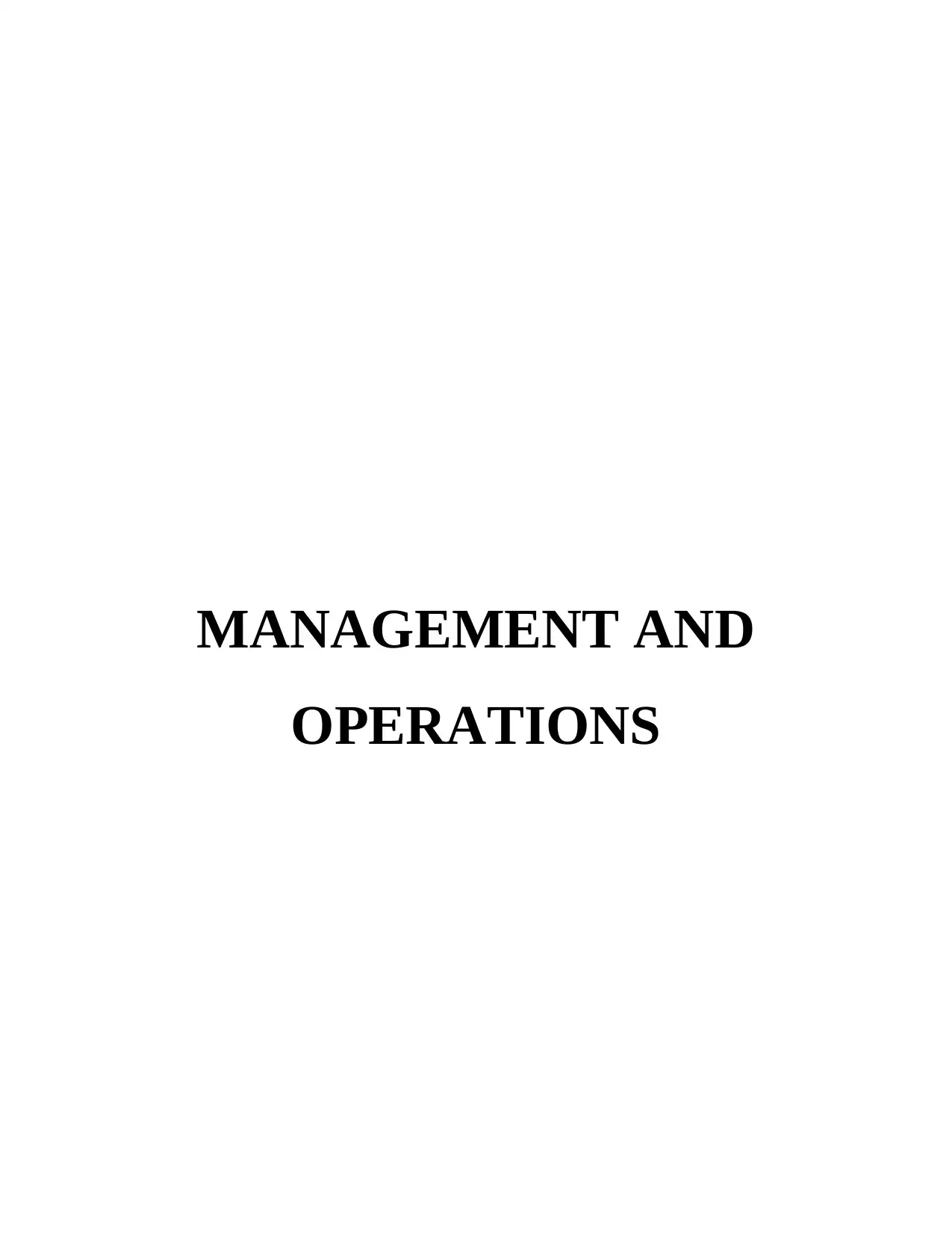
MANAGEMENT AND
OPERATIONS
OPERATIONS
Paraphrase This Document
Need a fresh take? Get an instant paraphrase of this document with our AI Paraphraser
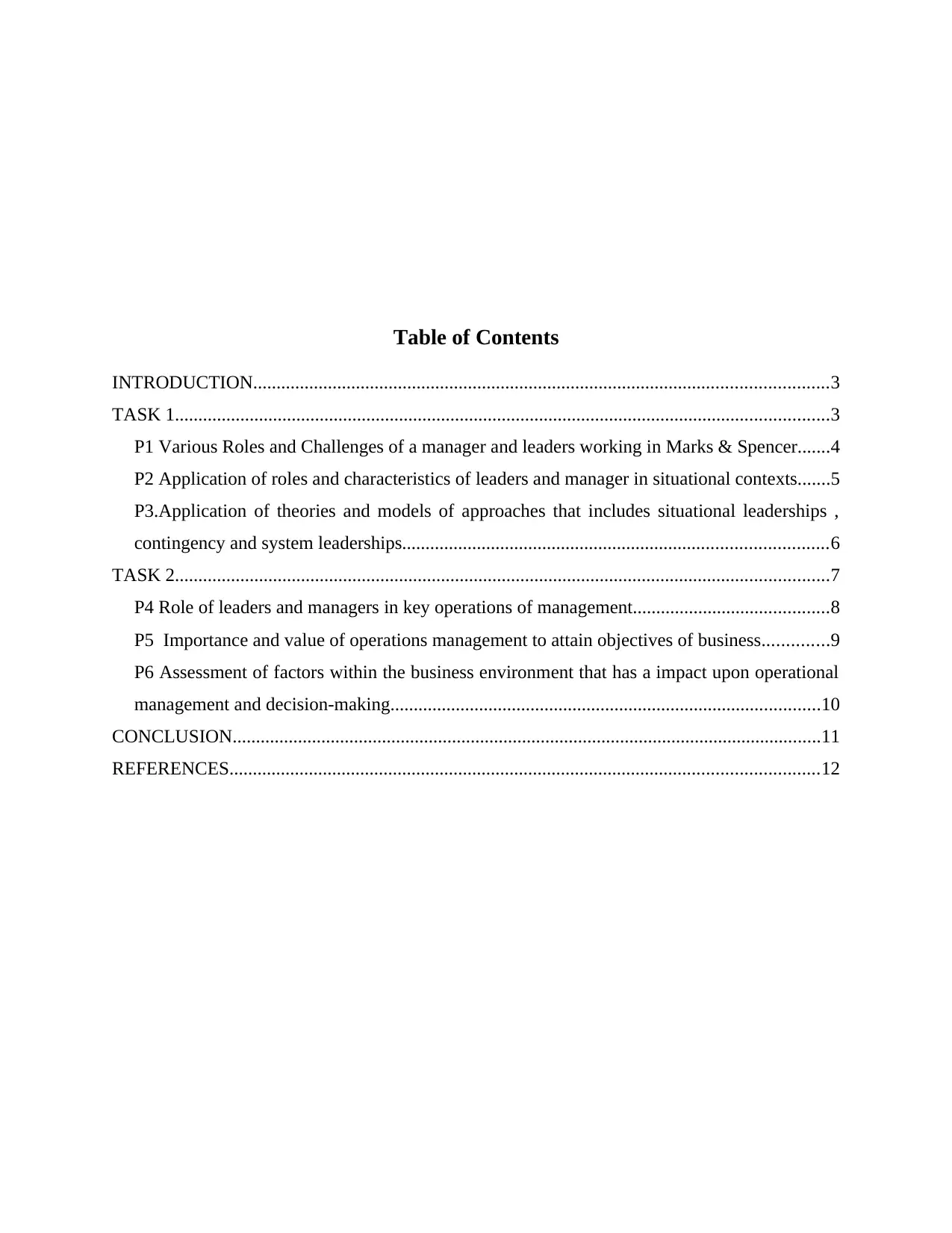
Table of Contents
INTRODUCTION...........................................................................................................................3
TASK 1............................................................................................................................................3
P1 Various Roles and Challenges of a manager and leaders working in Marks & Spencer.......4
P2 Application of roles and characteristics of leaders and manager in situational contexts.......5
P3.Application of theories and models of approaches that includes situational leaderships ,
contingency and system leaderships...........................................................................................6
TASK 2............................................................................................................................................7
P4 Role of leaders and managers in key operations of management..........................................8
P5 Importance and value of operations management to attain objectives of business..............9
P6 Assessment of factors within the business environment that has a impact upon operational
management and decision-making............................................................................................10
CONCLUSION..............................................................................................................................11
REFERENCES..............................................................................................................................12
INTRODUCTION...........................................................................................................................3
TASK 1............................................................................................................................................3
P1 Various Roles and Challenges of a manager and leaders working in Marks & Spencer.......4
P2 Application of roles and characteristics of leaders and manager in situational contexts.......5
P3.Application of theories and models of approaches that includes situational leaderships ,
contingency and system leaderships...........................................................................................6
TASK 2............................................................................................................................................7
P4 Role of leaders and managers in key operations of management..........................................8
P5 Importance and value of operations management to attain objectives of business..............9
P6 Assessment of factors within the business environment that has a impact upon operational
management and decision-making............................................................................................10
CONCLUSION..............................................................................................................................11
REFERENCES..............................................................................................................................12
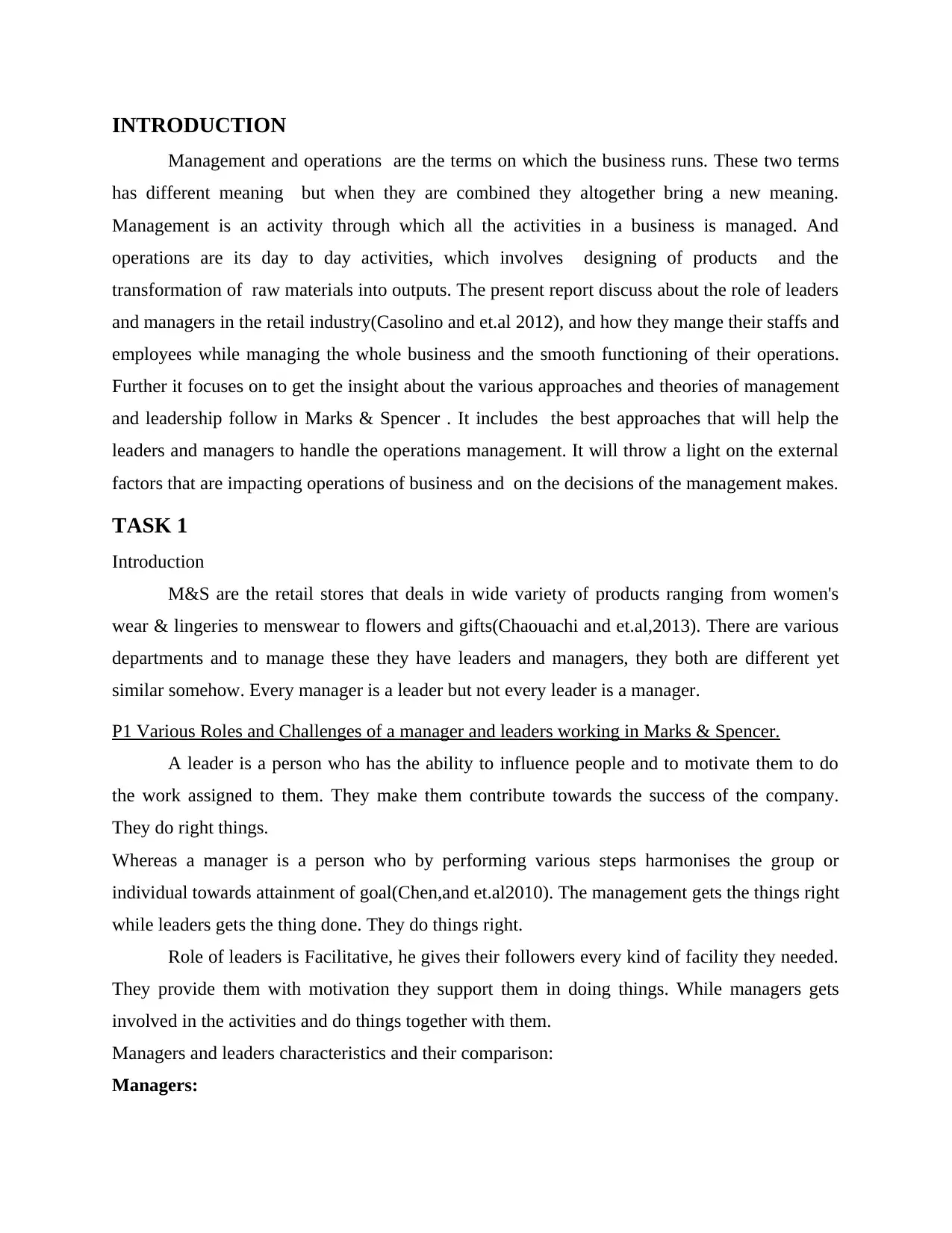
INTRODUCTION
Management and operations are the terms on which the business runs. These two terms
has different meaning but when they are combined they altogether bring a new meaning.
Management is an activity through which all the activities in a business is managed. And
operations are its day to day activities, which involves designing of products and the
transformation of raw materials into outputs. The present report discuss about the role of leaders
and managers in the retail industry(Casolino and et.al 2012), and how they mange their staffs and
employees while managing the whole business and the smooth functioning of their operations.
Further it focuses on to get the insight about the various approaches and theories of management
and leadership follow in Marks & Spencer . It includes the best approaches that will help the
leaders and managers to handle the operations management. It will throw a light on the external
factors that are impacting operations of business and on the decisions of the management makes.
TASK 1
Introduction
M&S are the retail stores that deals in wide variety of products ranging from women's
wear & lingeries to menswear to flowers and gifts(Chaouachi and et.al,2013). There are various
departments and to manage these they have leaders and managers, they both are different yet
similar somehow. Every manager is a leader but not every leader is a manager.
P1 Various Roles and Challenges of a manager and leaders working in Marks & Spencer.
A leader is a person who has the ability to influence people and to motivate them to do
the work assigned to them. They make them contribute towards the success of the company.
They do right things.
Whereas a manager is a person who by performing various steps harmonises the group or
individual towards attainment of goal(Chen,and et.al2010). The management gets the things right
while leaders gets the thing done. They do things right.
Role of leaders is Facilitative, he gives their followers every kind of facility they needed.
They provide them with motivation they support them in doing things. While managers gets
involved in the activities and do things together with them.
Managers and leaders characteristics and their comparison:
Managers:
Management and operations are the terms on which the business runs. These two terms
has different meaning but when they are combined they altogether bring a new meaning.
Management is an activity through which all the activities in a business is managed. And
operations are its day to day activities, which involves designing of products and the
transformation of raw materials into outputs. The present report discuss about the role of leaders
and managers in the retail industry(Casolino and et.al 2012), and how they mange their staffs and
employees while managing the whole business and the smooth functioning of their operations.
Further it focuses on to get the insight about the various approaches and theories of management
and leadership follow in Marks & Spencer . It includes the best approaches that will help the
leaders and managers to handle the operations management. It will throw a light on the external
factors that are impacting operations of business and on the decisions of the management makes.
TASK 1
Introduction
M&S are the retail stores that deals in wide variety of products ranging from women's
wear & lingeries to menswear to flowers and gifts(Chaouachi and et.al,2013). There are various
departments and to manage these they have leaders and managers, they both are different yet
similar somehow. Every manager is a leader but not every leader is a manager.
P1 Various Roles and Challenges of a manager and leaders working in Marks & Spencer.
A leader is a person who has the ability to influence people and to motivate them to do
the work assigned to them. They make them contribute towards the success of the company.
They do right things.
Whereas a manager is a person who by performing various steps harmonises the group or
individual towards attainment of goal(Chen,and et.al2010). The management gets the things right
while leaders gets the thing done. They do things right.
Role of leaders is Facilitative, he gives their followers every kind of facility they needed.
They provide them with motivation they support them in doing things. While managers gets
involved in the activities and do things together with them.
Managers and leaders characteristics and their comparison:
Managers:
⊘ This is a preview!⊘
Do you want full access?
Subscribe today to unlock all pages.

Trusted by 1+ million students worldwide
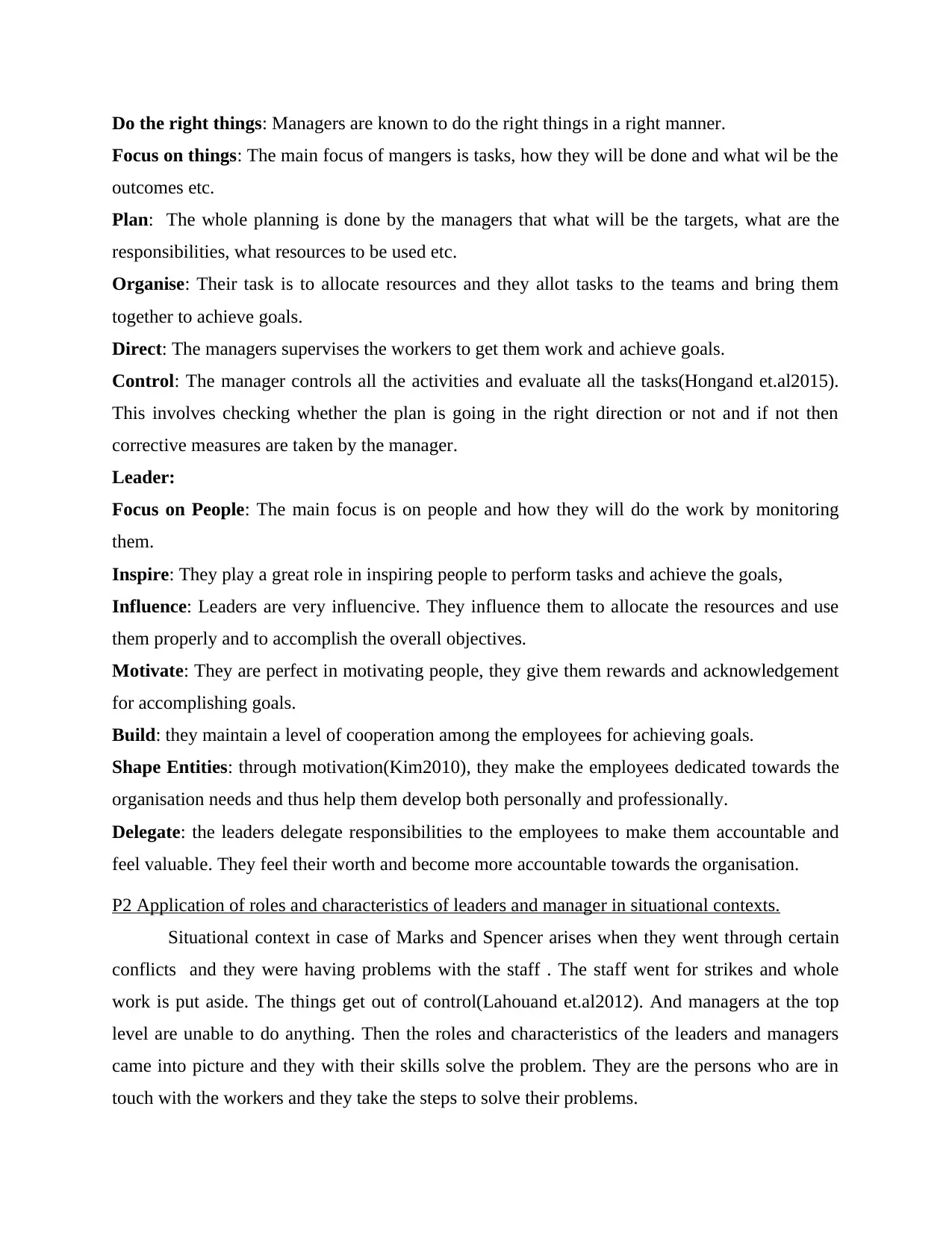
Do the right things: Managers are known to do the right things in a right manner.
Focus on things: The main focus of mangers is tasks, how they will be done and what wil be the
outcomes etc.
Plan: The whole planning is done by the managers that what will be the targets, what are the
responsibilities, what resources to be used etc.
Organise: Their task is to allocate resources and they allot tasks to the teams and bring them
together to achieve goals.
Direct: The managers supervises the workers to get them work and achieve goals.
Control: The manager controls all the activities and evaluate all the tasks(Hongand et.al2015).
This involves checking whether the plan is going in the right direction or not and if not then
corrective measures are taken by the manager.
Leader:
Focus on People: The main focus is on people and how they will do the work by monitoring
them.
Inspire: They play a great role in inspiring people to perform tasks and achieve the goals,
Influence: Leaders are very influencive. They influence them to allocate the resources and use
them properly and to accomplish the overall objectives.
Motivate: They are perfect in motivating people, they give them rewards and acknowledgement
for accomplishing goals.
Build: they maintain a level of cooperation among the employees for achieving goals.
Shape Entities: through motivation(Kim2010), they make the employees dedicated towards the
organisation needs and thus help them develop both personally and professionally.
Delegate: the leaders delegate responsibilities to the employees to make them accountable and
feel valuable. They feel their worth and become more accountable towards the organisation.
P2 Application of roles and characteristics of leaders and manager in situational contexts.
Situational context in case of Marks and Spencer arises when they went through certain
conflicts and they were having problems with the staff . The staff went for strikes and whole
work is put aside. The things get out of control(Lahouand et.al2012). And managers at the top
level are unable to do anything. Then the roles and characteristics of the leaders and managers
came into picture and they with their skills solve the problem. They are the persons who are in
touch with the workers and they take the steps to solve their problems.
Focus on things: The main focus of mangers is tasks, how they will be done and what wil be the
outcomes etc.
Plan: The whole planning is done by the managers that what will be the targets, what are the
responsibilities, what resources to be used etc.
Organise: Their task is to allocate resources and they allot tasks to the teams and bring them
together to achieve goals.
Direct: The managers supervises the workers to get them work and achieve goals.
Control: The manager controls all the activities and evaluate all the tasks(Hongand et.al2015).
This involves checking whether the plan is going in the right direction or not and if not then
corrective measures are taken by the manager.
Leader:
Focus on People: The main focus is on people and how they will do the work by monitoring
them.
Inspire: They play a great role in inspiring people to perform tasks and achieve the goals,
Influence: Leaders are very influencive. They influence them to allocate the resources and use
them properly and to accomplish the overall objectives.
Motivate: They are perfect in motivating people, they give them rewards and acknowledgement
for accomplishing goals.
Build: they maintain a level of cooperation among the employees for achieving goals.
Shape Entities: through motivation(Kim2010), they make the employees dedicated towards the
organisation needs and thus help them develop both personally and professionally.
Delegate: the leaders delegate responsibilities to the employees to make them accountable and
feel valuable. They feel their worth and become more accountable towards the organisation.
P2 Application of roles and characteristics of leaders and manager in situational contexts.
Situational context in case of Marks and Spencer arises when they went through certain
conflicts and they were having problems with the staff . The staff went for strikes and whole
work is put aside. The things get out of control(Lahouand et.al2012). And managers at the top
level are unable to do anything. Then the roles and characteristics of the leaders and managers
came into picture and they with their skills solve the problem. They are the persons who are in
touch with the workers and they take the steps to solve their problems.
Paraphrase This Document
Need a fresh take? Get an instant paraphrase of this document with our AI Paraphraser
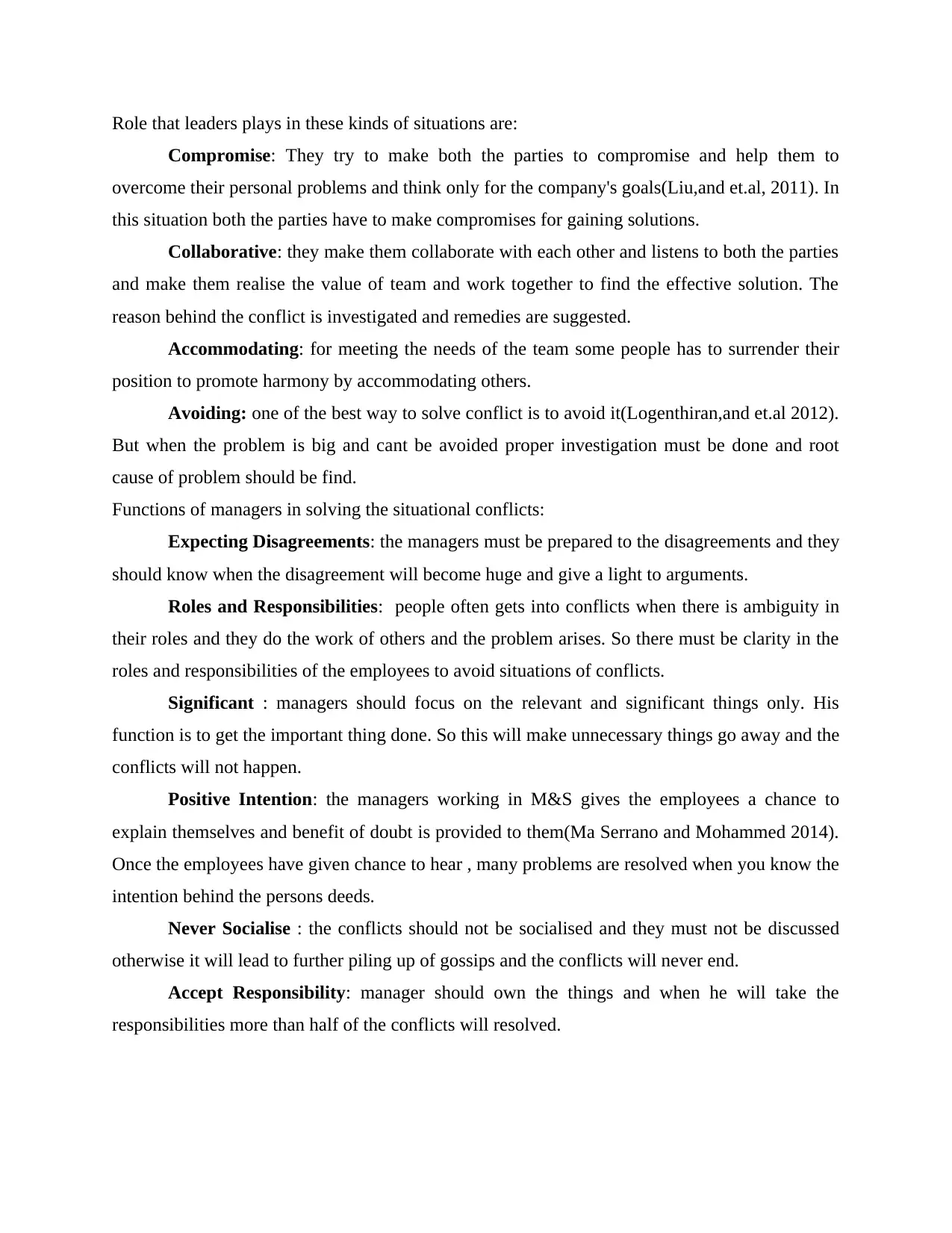
Role that leaders plays in these kinds of situations are:
Compromise: They try to make both the parties to compromise and help them to
overcome their personal problems and think only for the company's goals(Liu,and et.al, 2011). In
this situation both the parties have to make compromises for gaining solutions.
Collaborative: they make them collaborate with each other and listens to both the parties
and make them realise the value of team and work together to find the effective solution. The
reason behind the conflict is investigated and remedies are suggested.
Accommodating: for meeting the needs of the team some people has to surrender their
position to promote harmony by accommodating others.
Avoiding: one of the best way to solve conflict is to avoid it(Logenthiran,and et.al 2012).
But when the problem is big and cant be avoided proper investigation must be done and root
cause of problem should be find.
Functions of managers in solving the situational conflicts:
Expecting Disagreements: the managers must be prepared to the disagreements and they
should know when the disagreement will become huge and give a light to arguments.
Roles and Responsibilities: people often gets into conflicts when there is ambiguity in
their roles and they do the work of others and the problem arises. So there must be clarity in the
roles and responsibilities of the employees to avoid situations of conflicts.
Significant : managers should focus on the relevant and significant things only. His
function is to get the important thing done. So this will make unnecessary things go away and the
conflicts will not happen.
Positive Intention: the managers working in M&S gives the employees a chance to
explain themselves and benefit of doubt is provided to them(Ma Serrano and Mohammed 2014).
Once the employees have given chance to hear , many problems are resolved when you know the
intention behind the persons deeds.
Never Socialise : the conflicts should not be socialised and they must not be discussed
otherwise it will lead to further piling up of gossips and the conflicts will never end.
Accept Responsibility: manager should own the things and when he will take the
responsibilities more than half of the conflicts will resolved.
Compromise: They try to make both the parties to compromise and help them to
overcome their personal problems and think only for the company's goals(Liu,and et.al, 2011). In
this situation both the parties have to make compromises for gaining solutions.
Collaborative: they make them collaborate with each other and listens to both the parties
and make them realise the value of team and work together to find the effective solution. The
reason behind the conflict is investigated and remedies are suggested.
Accommodating: for meeting the needs of the team some people has to surrender their
position to promote harmony by accommodating others.
Avoiding: one of the best way to solve conflict is to avoid it(Logenthiran,and et.al 2012).
But when the problem is big and cant be avoided proper investigation must be done and root
cause of problem should be find.
Functions of managers in solving the situational conflicts:
Expecting Disagreements: the managers must be prepared to the disagreements and they
should know when the disagreement will become huge and give a light to arguments.
Roles and Responsibilities: people often gets into conflicts when there is ambiguity in
their roles and they do the work of others and the problem arises. So there must be clarity in the
roles and responsibilities of the employees to avoid situations of conflicts.
Significant : managers should focus on the relevant and significant things only. His
function is to get the important thing done. So this will make unnecessary things go away and the
conflicts will not happen.
Positive Intention: the managers working in M&S gives the employees a chance to
explain themselves and benefit of doubt is provided to them(Ma Serrano and Mohammed 2014).
Once the employees have given chance to hear , many problems are resolved when you know the
intention behind the persons deeds.
Never Socialise : the conflicts should not be socialised and they must not be discussed
otherwise it will lead to further piling up of gossips and the conflicts will never end.
Accept Responsibility: manager should own the things and when he will take the
responsibilities more than half of the conflicts will resolved.
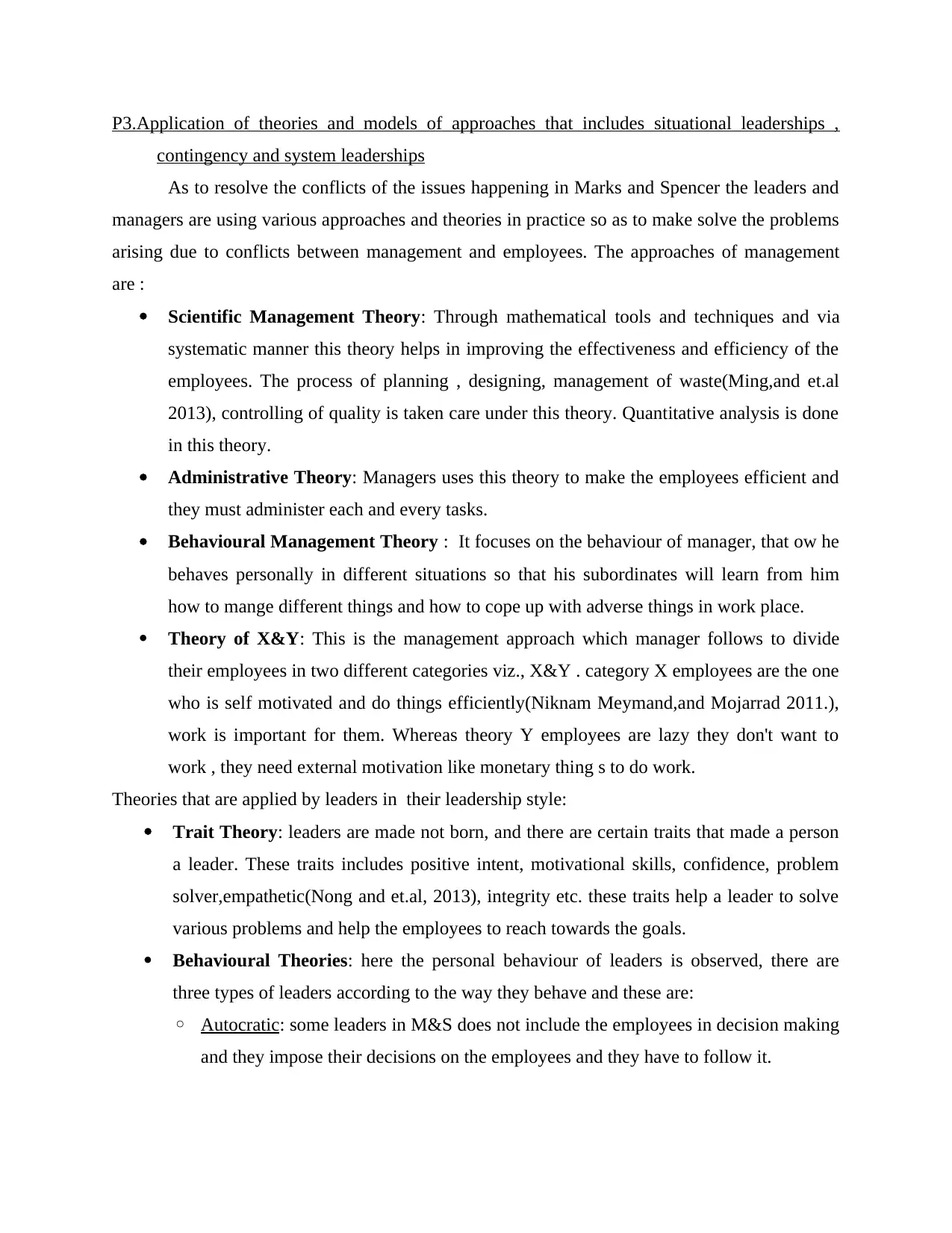
P3.Application of theories and models of approaches that includes situational leaderships ,
contingency and system leaderships
As to resolve the conflicts of the issues happening in Marks and Spencer the leaders and
managers are using various approaches and theories in practice so as to make solve the problems
arising due to conflicts between management and employees. The approaches of management
are :
Scientific Management Theory: Through mathematical tools and techniques and via
systematic manner this theory helps in improving the effectiveness and efficiency of the
employees. The process of planning , designing, management of waste(Ming,and et.al
2013), controlling of quality is taken care under this theory. Quantitative analysis is done
in this theory.
Administrative Theory: Managers uses this theory to make the employees efficient and
they must administer each and every tasks.
Behavioural Management Theory : It focuses on the behaviour of manager, that ow he
behaves personally in different situations so that his subordinates will learn from him
how to mange different things and how to cope up with adverse things in work place.
Theory of X&Y: This is the management approach which manager follows to divide
their employees in two different categories viz., X&Y . category X employees are the one
who is self motivated and do things efficiently(Niknam Meymand,and Mojarrad 2011.),
work is important for them. Whereas theory Y employees are lazy they don't want to
work , they need external motivation like monetary thing s to do work.
Theories that are applied by leaders in their leadership style:
Trait Theory: leaders are made not born, and there are certain traits that made a person
a leader. These traits includes positive intent, motivational skills, confidence, problem
solver,empathetic(Nong and et.al, 2013), integrity etc. these traits help a leader to solve
various problems and help the employees to reach towards the goals.
Behavioural Theories: here the personal behaviour of leaders is observed, there are
three types of leaders according to the way they behave and these are:
◦ Autocratic: some leaders in M&S does not include the employees in decision making
and they impose their decisions on the employees and they have to follow it.
contingency and system leaderships
As to resolve the conflicts of the issues happening in Marks and Spencer the leaders and
managers are using various approaches and theories in practice so as to make solve the problems
arising due to conflicts between management and employees. The approaches of management
are :
Scientific Management Theory: Through mathematical tools and techniques and via
systematic manner this theory helps in improving the effectiveness and efficiency of the
employees. The process of planning , designing, management of waste(Ming,and et.al
2013), controlling of quality is taken care under this theory. Quantitative analysis is done
in this theory.
Administrative Theory: Managers uses this theory to make the employees efficient and
they must administer each and every tasks.
Behavioural Management Theory : It focuses on the behaviour of manager, that ow he
behaves personally in different situations so that his subordinates will learn from him
how to mange different things and how to cope up with adverse things in work place.
Theory of X&Y: This is the management approach which manager follows to divide
their employees in two different categories viz., X&Y . category X employees are the one
who is self motivated and do things efficiently(Niknam Meymand,and Mojarrad 2011.),
work is important for them. Whereas theory Y employees are lazy they don't want to
work , they need external motivation like monetary thing s to do work.
Theories that are applied by leaders in their leadership style:
Trait Theory: leaders are made not born, and there are certain traits that made a person
a leader. These traits includes positive intent, motivational skills, confidence, problem
solver,empathetic(Nong and et.al, 2013), integrity etc. these traits help a leader to solve
various problems and help the employees to reach towards the goals.
Behavioural Theories: here the personal behaviour of leaders is observed, there are
three types of leaders according to the way they behave and these are:
◦ Autocratic: some leaders in M&S does not include the employees in decision making
and they impose their decisions on the employees and they have to follow it.
⊘ This is a preview!⊘
Do you want full access?
Subscribe today to unlock all pages.

Trusted by 1+ million students worldwide
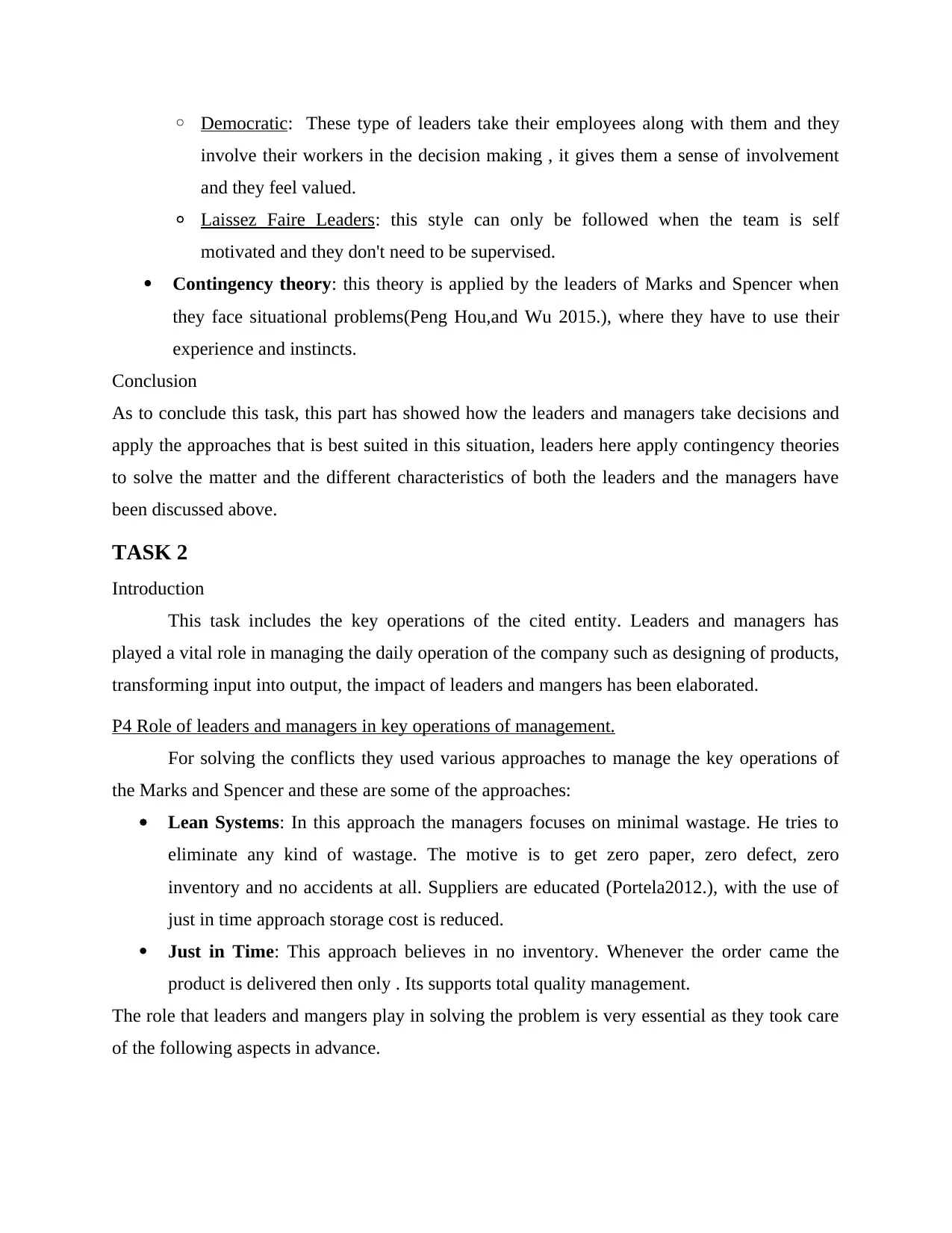
◦ Democratic: These type of leaders take their employees along with them and they
involve their workers in the decision making , it gives them a sense of involvement
and they feel valued.
◦ Laissez Faire Leaders: this style can only be followed when the team is self
motivated and they don't need to be supervised.
Contingency theory: this theory is applied by the leaders of Marks and Spencer when
they face situational problems(Peng Hou,and Wu 2015.), where they have to use their
experience and instincts.
Conclusion
As to conclude this task, this part has showed how the leaders and managers take decisions and
apply the approaches that is best suited in this situation, leaders here apply contingency theories
to solve the matter and the different characteristics of both the leaders and the managers have
been discussed above.
TASK 2
Introduction
This task includes the key operations of the cited entity. Leaders and managers has
played a vital role in managing the daily operation of the company such as designing of products,
transforming input into output, the impact of leaders and mangers has been elaborated.
P4 Role of leaders and managers in key operations of management.
For solving the conflicts they used various approaches to manage the key operations of
the Marks and Spencer and these are some of the approaches:
Lean Systems: In this approach the managers focuses on minimal wastage. He tries to
eliminate any kind of wastage. The motive is to get zero paper, zero defect, zero
inventory and no accidents at all. Suppliers are educated (Portela2012.), with the use of
just in time approach storage cost is reduced.
Just in Time: This approach believes in no inventory. Whenever the order came the
product is delivered then only . Its supports total quality management.
The role that leaders and mangers play in solving the problem is very essential as they took care
of the following aspects in advance.
involve their workers in the decision making , it gives them a sense of involvement
and they feel valued.
◦ Laissez Faire Leaders: this style can only be followed when the team is self
motivated and they don't need to be supervised.
Contingency theory: this theory is applied by the leaders of Marks and Spencer when
they face situational problems(Peng Hou,and Wu 2015.), where they have to use their
experience and instincts.
Conclusion
As to conclude this task, this part has showed how the leaders and managers take decisions and
apply the approaches that is best suited in this situation, leaders here apply contingency theories
to solve the matter and the different characteristics of both the leaders and the managers have
been discussed above.
TASK 2
Introduction
This task includes the key operations of the cited entity. Leaders and managers has
played a vital role in managing the daily operation of the company such as designing of products,
transforming input into output, the impact of leaders and mangers has been elaborated.
P4 Role of leaders and managers in key operations of management.
For solving the conflicts they used various approaches to manage the key operations of
the Marks and Spencer and these are some of the approaches:
Lean Systems: In this approach the managers focuses on minimal wastage. He tries to
eliminate any kind of wastage. The motive is to get zero paper, zero defect, zero
inventory and no accidents at all. Suppliers are educated (Portela2012.), with the use of
just in time approach storage cost is reduced.
Just in Time: This approach believes in no inventory. Whenever the order came the
product is delivered then only . Its supports total quality management.
The role that leaders and mangers play in solving the problem is very essential as they took care
of the following aspects in advance.
Paraphrase This Document
Need a fresh take? Get an instant paraphrase of this document with our AI Paraphraser
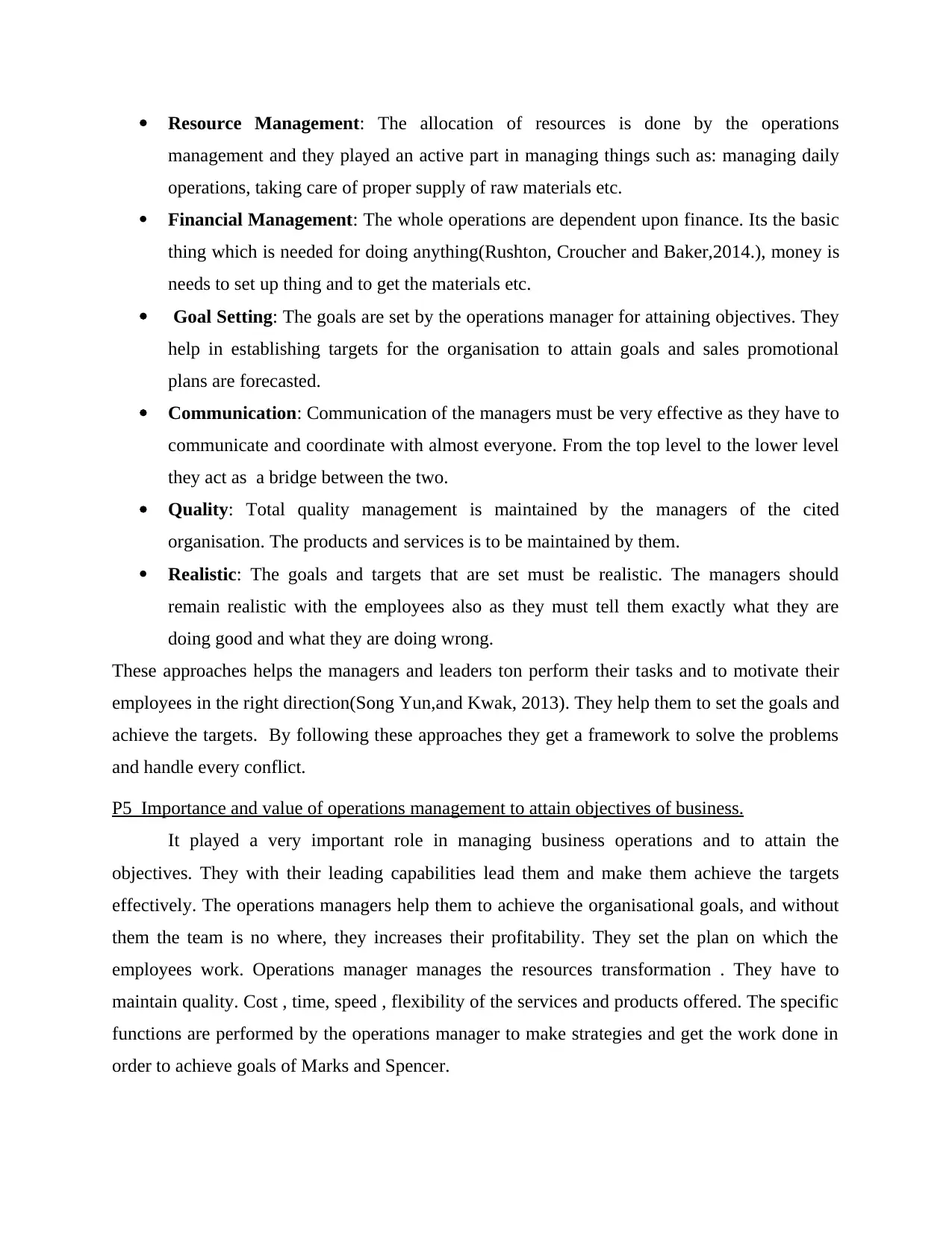
Resource Management: The allocation of resources is done by the operations
management and they played an active part in managing things such as: managing daily
operations, taking care of proper supply of raw materials etc.
Financial Management: The whole operations are dependent upon finance. Its the basic
thing which is needed for doing anything(Rushton, Croucher and Baker,2014.), money is
needs to set up thing and to get the materials etc.
Goal Setting: The goals are set by the operations manager for attaining objectives. They
help in establishing targets for the organisation to attain goals and sales promotional
plans are forecasted.
Communication: Communication of the managers must be very effective as they have to
communicate and coordinate with almost everyone. From the top level to the lower level
they act as a bridge between the two.
Quality: Total quality management is maintained by the managers of the cited
organisation. The products and services is to be maintained by them.
Realistic: The goals and targets that are set must be realistic. The managers should
remain realistic with the employees also as they must tell them exactly what they are
doing good and what they are doing wrong.
These approaches helps the managers and leaders ton perform their tasks and to motivate their
employees in the right direction(Song Yun,and Kwak, 2013). They help them to set the goals and
achieve the targets. By following these approaches they get a framework to solve the problems
and handle every conflict.
P5 Importance and value of operations management to attain objectives of business.
It played a very important role in managing business operations and to attain the
objectives. They with their leading capabilities lead them and make them achieve the targets
effectively. The operations managers help them to achieve the organisational goals, and without
them the team is no where, they increases their profitability. They set the plan on which the
employees work. Operations manager manages the resources transformation . They have to
maintain quality. Cost , time, speed , flexibility of the services and products offered. The specific
functions are performed by the operations manager to make strategies and get the work done in
order to achieve goals of Marks and Spencer.
management and they played an active part in managing things such as: managing daily
operations, taking care of proper supply of raw materials etc.
Financial Management: The whole operations are dependent upon finance. Its the basic
thing which is needed for doing anything(Rushton, Croucher and Baker,2014.), money is
needs to set up thing and to get the materials etc.
Goal Setting: The goals are set by the operations manager for attaining objectives. They
help in establishing targets for the organisation to attain goals and sales promotional
plans are forecasted.
Communication: Communication of the managers must be very effective as they have to
communicate and coordinate with almost everyone. From the top level to the lower level
they act as a bridge between the two.
Quality: Total quality management is maintained by the managers of the cited
organisation. The products and services is to be maintained by them.
Realistic: The goals and targets that are set must be realistic. The managers should
remain realistic with the employees also as they must tell them exactly what they are
doing good and what they are doing wrong.
These approaches helps the managers and leaders ton perform their tasks and to motivate their
employees in the right direction(Song Yun,and Kwak, 2013). They help them to set the goals and
achieve the targets. By following these approaches they get a framework to solve the problems
and handle every conflict.
P5 Importance and value of operations management to attain objectives of business.
It played a very important role in managing business operations and to attain the
objectives. They with their leading capabilities lead them and make them achieve the targets
effectively. The operations managers help them to achieve the organisational goals, and without
them the team is no where, they increases their profitability. They set the plan on which the
employees work. Operations manager manages the resources transformation . They have to
maintain quality. Cost , time, speed , flexibility of the services and products offered. The specific
functions are performed by the operations manager to make strategies and get the work done in
order to achieve goals of Marks and Spencer.
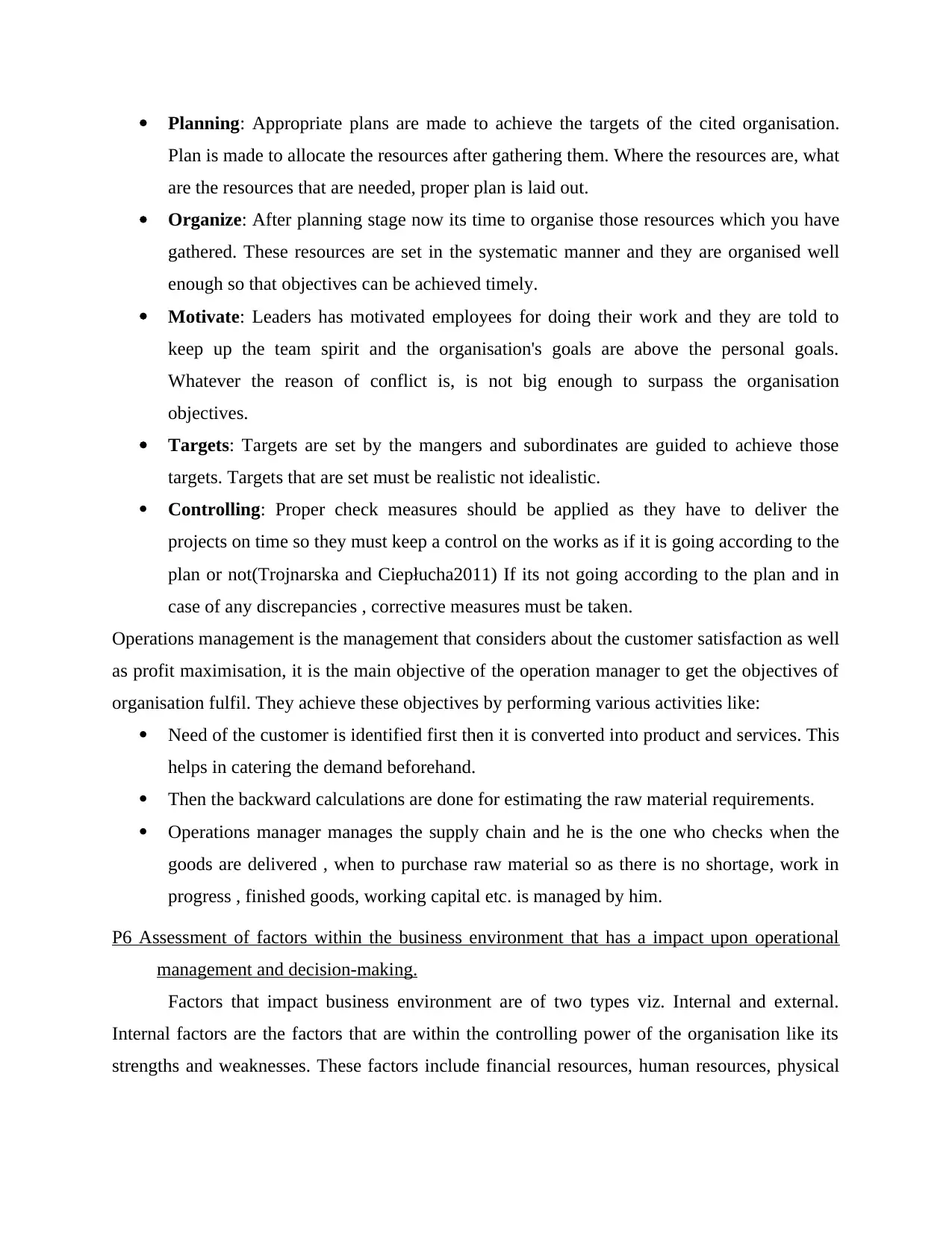
Planning: Appropriate plans are made to achieve the targets of the cited organisation.
Plan is made to allocate the resources after gathering them. Where the resources are, what
are the resources that are needed, proper plan is laid out.
Organize: After planning stage now its time to organise those resources which you have
gathered. These resources are set in the systematic manner and they are organised well
enough so that objectives can be achieved timely.
Motivate: Leaders has motivated employees for doing their work and they are told to
keep up the team spirit and the organisation's goals are above the personal goals.
Whatever the reason of conflict is, is not big enough to surpass the organisation
objectives.
Targets: Targets are set by the mangers and subordinates are guided to achieve those
targets. Targets that are set must be realistic not idealistic.
Controlling: Proper check measures should be applied as they have to deliver the
projects on time so they must keep a control on the works as if it is going according to the
plan or not(Trojnarska and Ciepłucha2011) If its not going according to the plan and in
case of any discrepancies , corrective measures must be taken.
Operations management is the management that considers about the customer satisfaction as well
as profit maximisation, it is the main objective of the operation manager to get the objectives of
organisation fulfil. They achieve these objectives by performing various activities like:
Need of the customer is identified first then it is converted into product and services. This
helps in catering the demand beforehand.
Then the backward calculations are done for estimating the raw material requirements.
Operations manager manages the supply chain and he is the one who checks when the
goods are delivered , when to purchase raw material so as there is no shortage, work in
progress , finished goods, working capital etc. is managed by him.
P6 Assessment of factors within the business environment that has a impact upon operational
management and decision-making.
Factors that impact business environment are of two types viz. Internal and external.
Internal factors are the factors that are within the controlling power of the organisation like its
strengths and weaknesses. These factors include financial resources, human resources, physical
Plan is made to allocate the resources after gathering them. Where the resources are, what
are the resources that are needed, proper plan is laid out.
Organize: After planning stage now its time to organise those resources which you have
gathered. These resources are set in the systematic manner and they are organised well
enough so that objectives can be achieved timely.
Motivate: Leaders has motivated employees for doing their work and they are told to
keep up the team spirit and the organisation's goals are above the personal goals.
Whatever the reason of conflict is, is not big enough to surpass the organisation
objectives.
Targets: Targets are set by the mangers and subordinates are guided to achieve those
targets. Targets that are set must be realistic not idealistic.
Controlling: Proper check measures should be applied as they have to deliver the
projects on time so they must keep a control on the works as if it is going according to the
plan or not(Trojnarska and Ciepłucha2011) If its not going according to the plan and in
case of any discrepancies , corrective measures must be taken.
Operations management is the management that considers about the customer satisfaction as well
as profit maximisation, it is the main objective of the operation manager to get the objectives of
organisation fulfil. They achieve these objectives by performing various activities like:
Need of the customer is identified first then it is converted into product and services. This
helps in catering the demand beforehand.
Then the backward calculations are done for estimating the raw material requirements.
Operations manager manages the supply chain and he is the one who checks when the
goods are delivered , when to purchase raw material so as there is no shortage, work in
progress , finished goods, working capital etc. is managed by him.
P6 Assessment of factors within the business environment that has a impact upon operational
management and decision-making.
Factors that impact business environment are of two types viz. Internal and external.
Internal factors are the factors that are within the controlling power of the organisation like its
strengths and weaknesses. These factors include financial resources, human resources, physical
⊘ This is a preview!⊘
Do you want full access?
Subscribe today to unlock all pages.

Trusted by 1+ million students worldwide
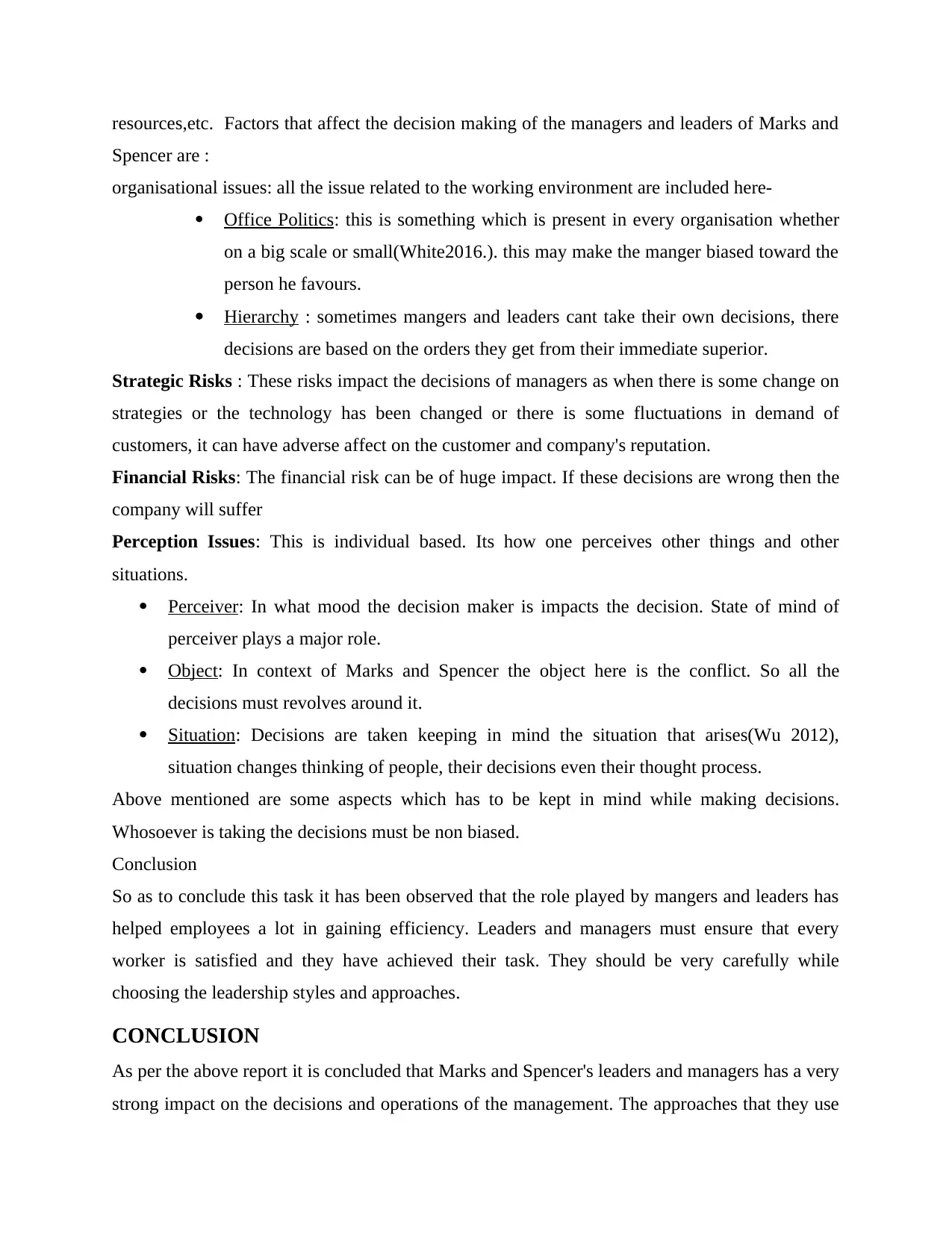
resources,etc. Factors that affect the decision making of the managers and leaders of Marks and
Spencer are :
organisational issues: all the issue related to the working environment are included here-
Office Politics: this is something which is present in every organisation whether
on a big scale or small(White2016.). this may make the manger biased toward the
person he favours.
Hierarchy : sometimes mangers and leaders cant take their own decisions, there
decisions are based on the orders they get from their immediate superior.
Strategic Risks : These risks impact the decisions of managers as when there is some change on
strategies or the technology has been changed or there is some fluctuations in demand of
customers, it can have adverse affect on the customer and company's reputation.
Financial Risks: The financial risk can be of huge impact. If these decisions are wrong then the
company will suffer
Perception Issues: This is individual based. Its how one perceives other things and other
situations.
Perceiver: In what mood the decision maker is impacts the decision. State of mind of
perceiver plays a major role.
Object: In context of Marks and Spencer the object here is the conflict. So all the
decisions must revolves around it.
Situation: Decisions are taken keeping in mind the situation that arises(Wu 2012),
situation changes thinking of people, their decisions even their thought process.
Above mentioned are some aspects which has to be kept in mind while making decisions.
Whosoever is taking the decisions must be non biased.
Conclusion
So as to conclude this task it has been observed that the role played by mangers and leaders has
helped employees a lot in gaining efficiency. Leaders and managers must ensure that every
worker is satisfied and they have achieved their task. They should be very carefully while
choosing the leadership styles and approaches.
CONCLUSION
As per the above report it is concluded that Marks and Spencer's leaders and managers has a very
strong impact on the decisions and operations of the management. The approaches that they use
Spencer are :
organisational issues: all the issue related to the working environment are included here-
Office Politics: this is something which is present in every organisation whether
on a big scale or small(White2016.). this may make the manger biased toward the
person he favours.
Hierarchy : sometimes mangers and leaders cant take their own decisions, there
decisions are based on the orders they get from their immediate superior.
Strategic Risks : These risks impact the decisions of managers as when there is some change on
strategies or the technology has been changed or there is some fluctuations in demand of
customers, it can have adverse affect on the customer and company's reputation.
Financial Risks: The financial risk can be of huge impact. If these decisions are wrong then the
company will suffer
Perception Issues: This is individual based. Its how one perceives other things and other
situations.
Perceiver: In what mood the decision maker is impacts the decision. State of mind of
perceiver plays a major role.
Object: In context of Marks and Spencer the object here is the conflict. So all the
decisions must revolves around it.
Situation: Decisions are taken keeping in mind the situation that arises(Wu 2012),
situation changes thinking of people, their decisions even their thought process.
Above mentioned are some aspects which has to be kept in mind while making decisions.
Whosoever is taking the decisions must be non biased.
Conclusion
So as to conclude this task it has been observed that the role played by mangers and leaders has
helped employees a lot in gaining efficiency. Leaders and managers must ensure that every
worker is satisfied and they have achieved their task. They should be very carefully while
choosing the leadership styles and approaches.
CONCLUSION
As per the above report it is concluded that Marks and Spencer's leaders and managers has a very
strong impact on the decisions and operations of the management. The approaches that they use
Paraphrase This Document
Need a fresh take? Get an instant paraphrase of this document with our AI Paraphraser
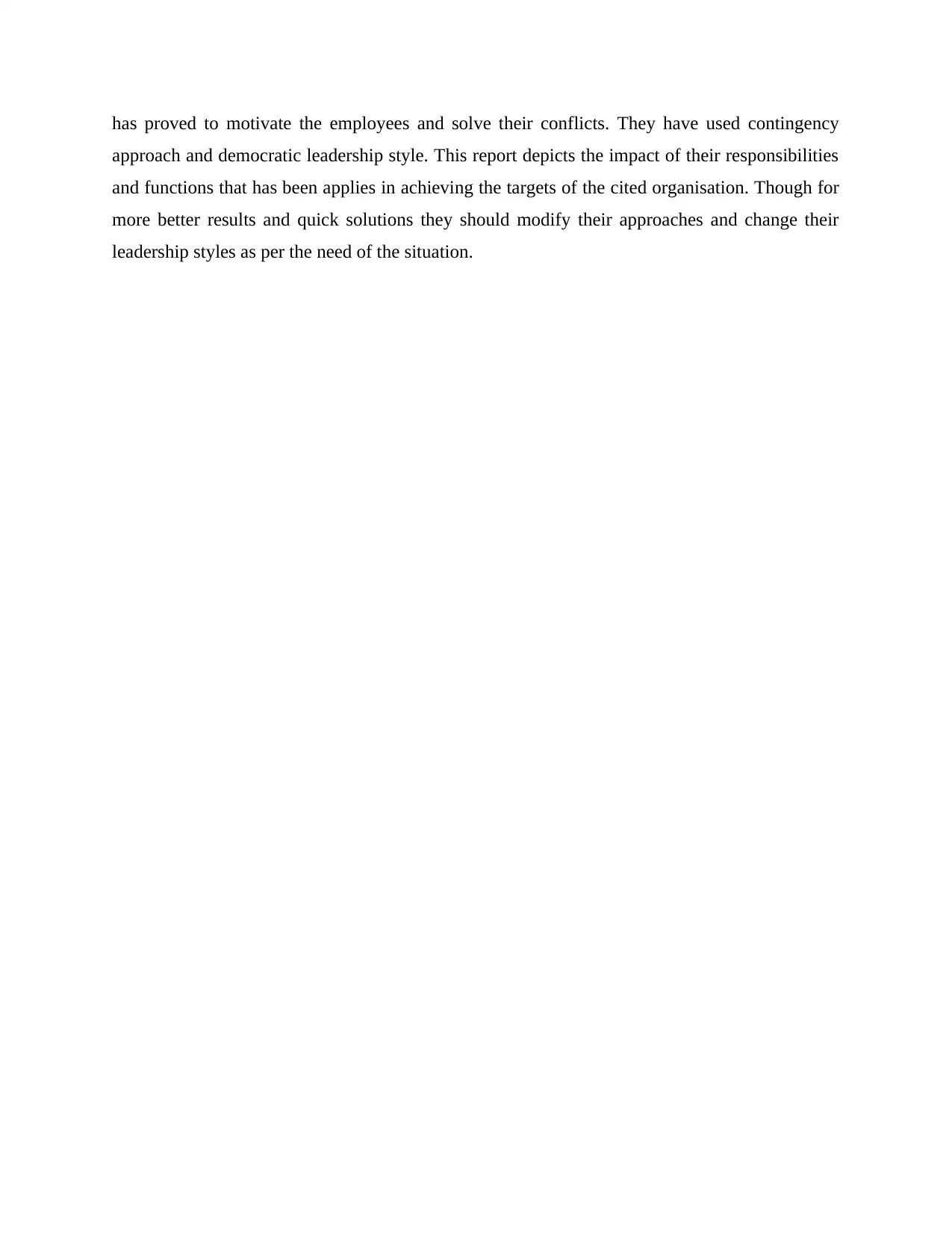
has proved to motivate the employees and solve their conflicts. They have used contingency
approach and democratic leadership style. This report depicts the impact of their responsibilities
and functions that has been applies in achieving the targets of the cited organisation. Though for
more better results and quick solutions they should modify their approaches and change their
leadership styles as per the need of the situation.
approach and democratic leadership style. This report depicts the impact of their responsibilities
and functions that has been applies in achieving the targets of the cited organisation. Though for
more better results and quick solutions they should modify their approaches and change their
leadership styles as per the need of the situation.
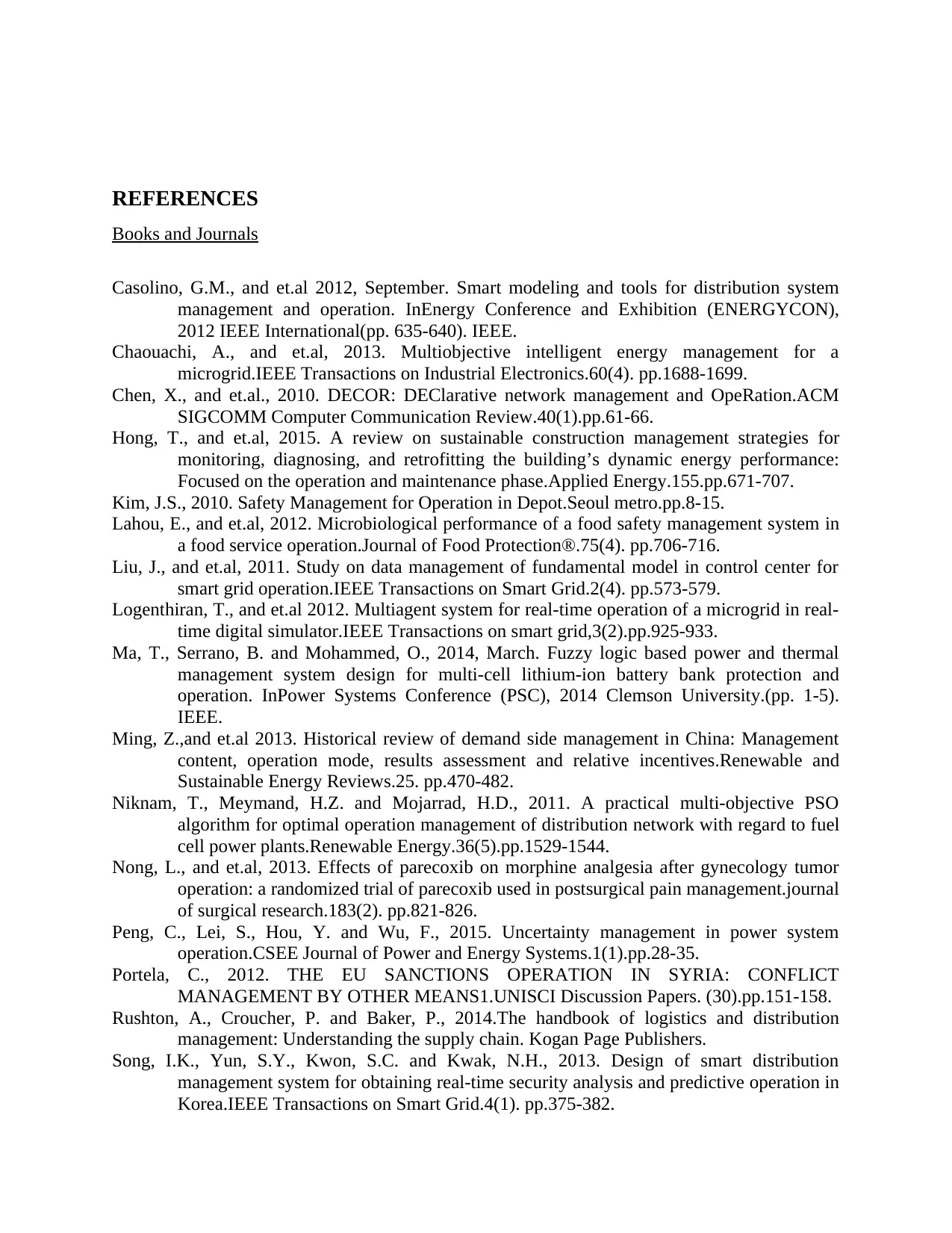
REFERENCES
Books and Journals
Casolino, G.M., and et.al 2012, September. Smart modeling and tools for distribution system
management and operation. InEnergy Conference and Exhibition (ENERGYCON),
2012 IEEE International(pp. 635-640). IEEE.
Chaouachi, A., and et.al, 2013. Multiobjective intelligent energy management for a
microgrid.IEEE Transactions on Industrial Electronics.60(4). pp.1688-1699.
Chen, X., and et.al., 2010. DECOR: DEClarative network management and OpeRation.ACM
SIGCOMM Computer Communication Review.40(1).pp.61-66.
Hong, T., and et.al, 2015. A review on sustainable construction management strategies for
monitoring, diagnosing, and retrofitting the building’s dynamic energy performance:
Focused on the operation and maintenance phase.Applied Energy.155.pp.671-707.
Kim, J.S., 2010. Safety Management for Operation in Depot.Seoul metro.pp.8-15.
Lahou, E., and et.al, 2012. Microbiological performance of a food safety management system in
a food service operation.Journal of Food Protection®.75(4). pp.706-716.
Liu, J., and et.al, 2011. Study on data management of fundamental model in control center for
smart grid operation.IEEE Transactions on Smart Grid.2(4). pp.573-579.
Logenthiran, T., and et.al 2012. Multiagent system for real-time operation of a microgrid in real-
time digital simulator.IEEE Transactions on smart grid,3(2).pp.925-933.
Ma, T., Serrano, B. and Mohammed, O., 2014, March. Fuzzy logic based power and thermal
management system design for multi-cell lithium-ion battery bank protection and
operation. InPower Systems Conference (PSC), 2014 Clemson University.(pp. 1-5).
IEEE.
Ming, Z.,and et.al 2013. Historical review of demand side management in China: Management
content, operation mode, results assessment and relative incentives.Renewable and
Sustainable Energy Reviews.25. pp.470-482.
Niknam, T., Meymand, H.Z. and Mojarrad, H.D., 2011. A practical multi-objective PSO
algorithm for optimal operation management of distribution network with regard to fuel
cell power plants.Renewable Energy.36(5).pp.1529-1544.
Nong, L., and et.al, 2013. Effects of parecoxib on morphine analgesia after gynecology tumor
operation: a randomized trial of parecoxib used in postsurgical pain management.journal
of surgical research.183(2). pp.821-826.
Peng, C., Lei, S., Hou, Y. and Wu, F., 2015. Uncertainty management in power system
operation.CSEE Journal of Power and Energy Systems.1(1).pp.28-35.
Portela, C., 2012. THE EU SANCTIONS OPERATION IN SYRIA: CONFLICT
MANAGEMENT BY OTHER MEANS1.UNISCI Discussion Papers. (30).pp.151-158.
Rushton, A., Croucher, P. and Baker, P., 2014.The handbook of logistics and distribution
management: Understanding the supply chain. Kogan Page Publishers.
Song, I.K., Yun, S.Y., Kwon, S.C. and Kwak, N.H., 2013. Design of smart distribution
management system for obtaining real-time security analysis and predictive operation in
Korea.IEEE Transactions on Smart Grid.4(1). pp.375-382.
Books and Journals
Casolino, G.M., and et.al 2012, September. Smart modeling and tools for distribution system
management and operation. InEnergy Conference and Exhibition (ENERGYCON),
2012 IEEE International(pp. 635-640). IEEE.
Chaouachi, A., and et.al, 2013. Multiobjective intelligent energy management for a
microgrid.IEEE Transactions on Industrial Electronics.60(4). pp.1688-1699.
Chen, X., and et.al., 2010. DECOR: DEClarative network management and OpeRation.ACM
SIGCOMM Computer Communication Review.40(1).pp.61-66.
Hong, T., and et.al, 2015. A review on sustainable construction management strategies for
monitoring, diagnosing, and retrofitting the building’s dynamic energy performance:
Focused on the operation and maintenance phase.Applied Energy.155.pp.671-707.
Kim, J.S., 2010. Safety Management for Operation in Depot.Seoul metro.pp.8-15.
Lahou, E., and et.al, 2012. Microbiological performance of a food safety management system in
a food service operation.Journal of Food Protection®.75(4). pp.706-716.
Liu, J., and et.al, 2011. Study on data management of fundamental model in control center for
smart grid operation.IEEE Transactions on Smart Grid.2(4). pp.573-579.
Logenthiran, T., and et.al 2012. Multiagent system for real-time operation of a microgrid in real-
time digital simulator.IEEE Transactions on smart grid,3(2).pp.925-933.
Ma, T., Serrano, B. and Mohammed, O., 2014, March. Fuzzy logic based power and thermal
management system design for multi-cell lithium-ion battery bank protection and
operation. InPower Systems Conference (PSC), 2014 Clemson University.(pp. 1-5).
IEEE.
Ming, Z.,and et.al 2013. Historical review of demand side management in China: Management
content, operation mode, results assessment and relative incentives.Renewable and
Sustainable Energy Reviews.25. pp.470-482.
Niknam, T., Meymand, H.Z. and Mojarrad, H.D., 2011. A practical multi-objective PSO
algorithm for optimal operation management of distribution network with regard to fuel
cell power plants.Renewable Energy.36(5).pp.1529-1544.
Nong, L., and et.al, 2013. Effects of parecoxib on morphine analgesia after gynecology tumor
operation: a randomized trial of parecoxib used in postsurgical pain management.journal
of surgical research.183(2). pp.821-826.
Peng, C., Lei, S., Hou, Y. and Wu, F., 2015. Uncertainty management in power system
operation.CSEE Journal of Power and Energy Systems.1(1).pp.28-35.
Portela, C., 2012. THE EU SANCTIONS OPERATION IN SYRIA: CONFLICT
MANAGEMENT BY OTHER MEANS1.UNISCI Discussion Papers. (30).pp.151-158.
Rushton, A., Croucher, P. and Baker, P., 2014.The handbook of logistics and distribution
management: Understanding the supply chain. Kogan Page Publishers.
Song, I.K., Yun, S.Y., Kwon, S.C. and Kwak, N.H., 2013. Design of smart distribution
management system for obtaining real-time security analysis and predictive operation in
Korea.IEEE Transactions on Smart Grid.4(1). pp.375-382.
⊘ This is a preview!⊘
Do you want full access?
Subscribe today to unlock all pages.

Trusted by 1+ million students worldwide
1 out of 13
Related Documents
Your All-in-One AI-Powered Toolkit for Academic Success.
+13062052269
info@desklib.com
Available 24*7 on WhatsApp / Email
![[object Object]](/_next/static/media/star-bottom.7253800d.svg)
Unlock your academic potential
Copyright © 2020–2025 A2Z Services. All Rights Reserved. Developed and managed by ZUCOL.





